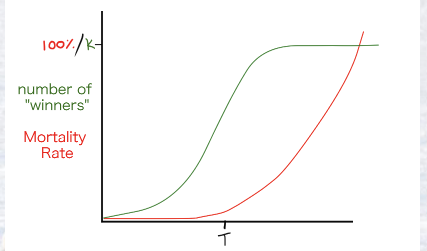3 - Populations, Survivorship Curves & Competition
1/27
There's no tags or description
Looks like no tags are added yet.
Name | Mastery | Learn | Test | Matching | Spaced |
|---|
No study sessions yet.
28 Terms
Define a life table
a numerical summary of the products of fecundity and mortality of a population
What does a life table allow us to do?
look at the changing nature of populations and predict future trends
Life tables: define ax
number alive at the start of a stage
Life tables: define lx
proportion of the original cohort surviving to the start of stage x.
Life tables: define dx
proportion of the original cohort that “dies” in that stage
Life tables: define qx
stage specific mortality rate (dx / lx)
Life tables: define Fx
total fecundity - the number of offspring produced by the cohort at that stage
Life tables: define mx
individual fecundity (Fx / ax) - how many offspring are being produced on average per individual
Life tables: define lx mx
the fecundity per original cohort member (Fx / ao)
Life tables: define Ro
basic reproductive rate - mean number of offspring produced per individual at the end of cohort
Ro = 1
population is stable
Ro < 1
population is in decline
Ro > 1
population is increasing / too high
Survivorship curves
plotting out mortality over time to see changes of development
State the 2 major reproductive strategies
r and k
Define r selection strategy
having very numerous young, but with little investment per individual
Define k selection strategy
having few offspring but investing heavily in each one
State population structure as a result of r strategy
will have a population structure heavily biased to juvniles
State population structure as a result of k strategy
will have a population structure biased towards adults
Define interspecific competition
competition between species
Define direct interspecific competition
two species directly fighting over a resource
Define indirect interspecific competition
two species eating the same resource but with no direct fighting
Define intraspecific competition
competition between individuals of a single species
State the two extremes of intraspecific competition
scramble and contest competition

Define scramble competition
all individuals scrambling for the resource with none likely getting enough to sustain them

Define contest competition
direct fight as to who gets a resource, with the winner getting enough to sustain them
Define population density
population size over a given area
State two measurements of population density
absolute and relative